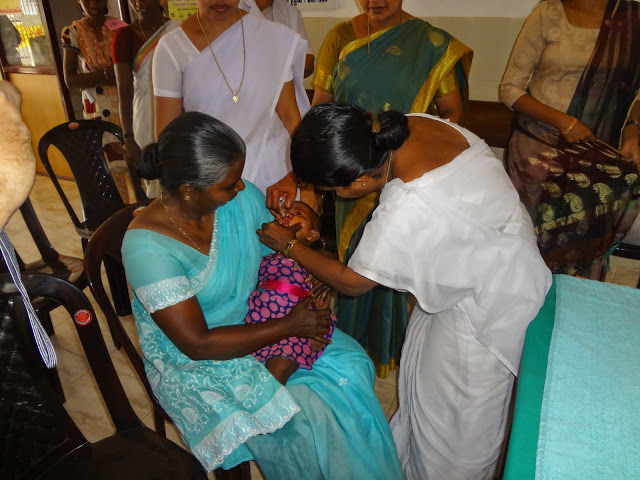Picture this – three JPHNs (Junior Public Health Nurse), one JHI (Junior Health Inspector) carrying white boxes about the size of a laptop, which we call vaccine carriers and cold boxes. These boxes contains vaccines of course. They are walking on a dirt track, and I was following them since I didn’t know the way around.We were going to a house which was about 5 kms away from the hospital. I had my steth, torch, pulse-oximeter prescription pad all tucked in my backpack. We were on a walk, and it was called the “Immune Walk”.
Our aim was simple – to vaccinate all the un-immunised and partially immunised children in our area and to make them fully immunised. Immunisation is the process of getting vaccinated by the way. Un-immunised includes those children who have never been vaccinated and partially immunised children are those who have not completely taken the recommended vaccinations for their age. In 2012, there were about 250 partially immunised and 20 un-immunised children under the PHC.
There are many reasons why some areas have such high numbers of un-immunised children. Religious beliefs is one of the main reason in our area. Ignorance is the second most common reason. There were some mothers who strongly believed that vaccination was just a process of makings their little babies infected with viruses and bacterias artificially and so they simply refused it. Some others believed that the injections administered on the child’s thighs would make them paralysed!. There was one incident when an old lady accused that we were doing this only because we get special allowances from the Government!
“I am educated, I know the importance of vaccination, but my husband who is working abroad has strictly forbidden me from vaccinating our kids, I am sorry” one of the mothers said when we tried to make her agree for the vaccination process at her home.
That is the main purpose of the so called ‘Immune Walk’ programme. We visit the houses of those children who have not been immunised yet and administer the vaccine there. It is a risky thing to do, and even harder to convince them, but still we do it nonetheless.We visit the colonies where migrants from other states lives with their families and give them various health services including immunisation. We can only visit a maximum of about 10 houses a day, and make a few children fully immunised. The ones who agree to administer the vaccine are those mothers who have been lazy enough to take their babies to the nearest health facility for Immunisation.
 |
| Polio vaccine being given to a child at PHC Muttam |
After completing almost 30 such ‘Immune Walk’ programmes, I can tell you that even though it is a risky job to administer the vaccines at the peripheries, the results are exceptionally good. We have reduced the numbers of un-immunised and partially immunised children to 5 and 60 respectively in the past two years. The remaining un-immunised child’s families are so adamant and cannot be persuaded in any means. At the end of the day, it is the parents who decide what is good for their children, we can only advice them. If you want to know more about this programme, we can discuss it in the comments below.
“Do vaccinate your children” 🙂
P.S – The last time we conducted an Immune Walk programme was in 2015. Now, a similar campaign called “Mission Indradanush” is doing it’s rounds in the districts of Kerala including ours. I’ll be writing about this new programme shortly.
Till then…